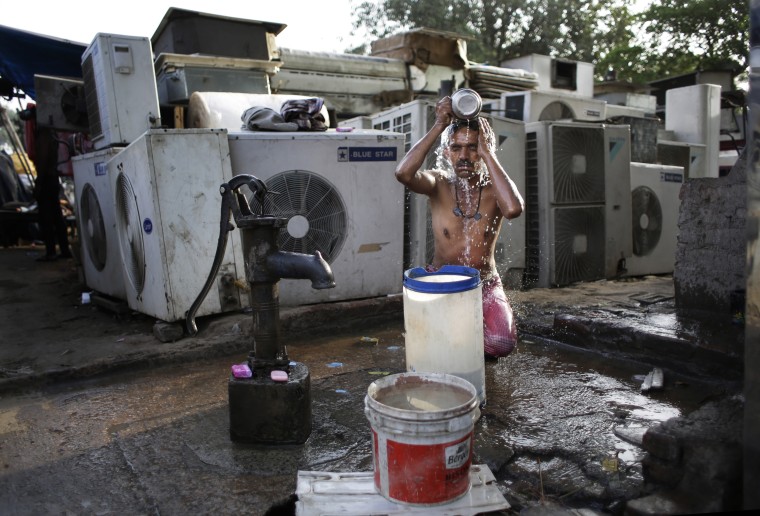World leaders have committed to limiting Earth’s rising temperature to 1.5 degrees Celsius (2.7 degrees Fahrenheit) above pre-industrial times.
But what does that feel like?
It’s difficult to convey, because you may not notice changes in average temperature. But, depending on where you live, you might notice when it’s extremely hot.
To better understand the issue, Columbia University’s climate school recently published a global dataset with estimates of both population and temperature. The Associated Press analyzed the data — spanning 1983 to 2016 — and found that exposure to extreme heat has tripled and now affects about a quarter of the world’s population.
How heat is measured
As the global average temperature rises, so do the hottest daily temperatures. And, in some places, the hottest days can be dangerous to human health, causing heat stress.
Heat stress can create a host of health problems, including rashes, cramps and heat stroke. Hot air is not the only risk factor for it. Other factors include humidity, wind speed and the amount of shade.
You may be familiar with the heat index, which takes into consideration temperature and humidity to suggest what it feels like in the shade on a hot day. But even the heat index doesn’t tell you what it’s like to be working in the full sun on an extremely hot windless day.
Increasingly, climate scientists and meteorologists are advocating for the use of a different metric for understanding extreme heat. It’s called wet-bulb globe temperature and it takes into account temperature, humidity, wind speed, sun angle and cloud cover.
The new dataset uses estimates of both population and wet-bulb globe temperature to better understand how many people are affected by dangerously hot temperatures and where they live.
When the wet-bulb globe temperature exceeds 30 degrees Celsius (86 degrees Fahrenheit), people are advised to start taking rests if they’re working outdoors.
Heat exposure rising
To match heat measures with population estimates, the researchers averaged temperature data over 13,115 urban centers identified in a dataset produced by the European Union.
Out of those urban centers around the world, nearly half experienced an increasing trend in heat exposure.
In 2016, just under 1.7 billion people lived in those areas, with the majority in Asia and sub-Saharan Africa.
The most affected region, by far, was southern Asia, where India alone accounted for 37 percent of the population living in areas with an increasing extreme heat trend.
With population growth from 1983 to 2016 for each city and estimates for the year-to-year increase in annual counts of dangerously hot days, the AP was able to identify the cities in the world where exposure to extreme heat is increasing most.
In Dhaka, Bangladesh, the population more than tripled from about 7.7 million in 1983 to 24 million in 2016. While the city grew by more than 16 million people, the number of extreme heat days also increased by 1.5 days a year, until Dhaka experienced about 50 more dangerously hot days a year than it did in 1983.
This large population growth, along with the warming trend for the area, reveals that Dhaka had the biggest increase in heat exposure in the world.
Population growth and increasing temperature both contribute to exposure trends. In some cases, these have an equal effect. That was the case in Kolkata, India, where the population grew by 6 million people and the number of hot days grew by 1.76 each year. Both of these increases contributed to a steep exposure trend.
Meanwhile, New Delhi added nearly 14 million people. While the city added 1.12 additional hot days each year, the population increase is what made Delhi’s exposure trend the steepest in India.
Indonesia's capital
This dataset focuses on the past, but could help world leaders make more informed decisions in the future. Indonesia is planning to move the country’s capital from Jakarta — a city that is sinking below sea level — to Kalimantan. The development site is in an area of jungle between two cities, Samarinda and Balikpapan. Both cities have increasing heat exposure trends.
People in Balikpapan, located at the mouth of the Bakpapan Bay, could expect 10 more days of extreme heat in 2016 compared with 1983.
Samarinda, situated on the humid Mahakam River delta, could expect 19 more days. Jakarta, although sinking, did not register a significant increasing exposure trend in the dataset.
Africa's growing cities
Many cities that already experience extreme heat are growing rapidly.
Douala, Cameroon, grew from roughly 760,000 people in 1983 to nearly 3 million in 2016. United Nations population projections suggest that count will double by 2035. Douala’s citizens endured 76 days of extreme heat in 2016.
Douala is representative of sub-Saharan Africa as a whole. According to the 2019 U.N. World Population Prospects, most of the world’s population growth will come from this region in the coming years, and it’s growing rapidly at a time when warming trends are increasing in cities across the area. Whether world leaders are able to limit the rise in the global average temperature, people in this part of the world will likely feel the difference in the resulting heat exposure most.
Dim Coumou, a climate professor at Vrije Universiteit Amsterdam, said the combination of growth in African cities and climate change presents a serious risk.
“As the population increases in these megacities, you have more buildings, more concrete and an increased heat-island effect, making the heat waves worse,” Coumou said. “I think it’s a dangerous combination.”
